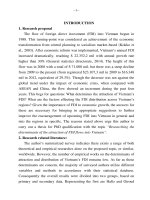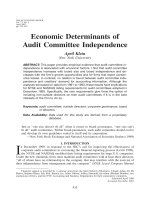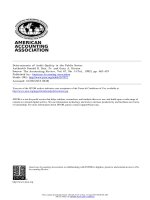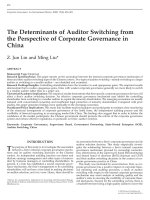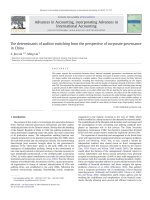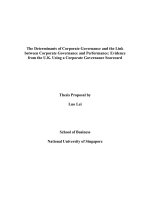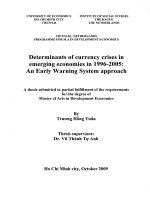Determinants of brand preference of mobile phone (hand set) case of high profile investors
Bạn đang xem bản rút gọn của tài liệu. Xem và tải ngay bản đầy đủ của tài liệu tại đây (713.19 KB, 92 trang )
Addis Ababa University Collage of Commerce Department of Marketing
Management Post Graduate Program
“Determinants of brand preference of mobile phone (hand set)
case of high profile investors”
By:
Mikias Tadese Id GSR/2798/07
Adviser: -Getie Andualem (Phd)
Research Paper Submitted To the Department of Marketing Management of Addis
Ababa University School of Commerce in Partial Fulfillment of the Requirements for
the Degree of Masters of Arts in Marketing Management
May, 2016
Addis Ababa
0
ADDIS ABABA UNIVERSIRT SCHOOL OF COMMERCE
MARKETING MANAGEMENT POST GRADUATE PROGRAMME
Declaration
I, Mikias Tadese, declare that this research paper entitled “determinants of brand
preference of mobile phone case of high profile investors ” is my original work and
has not been used by others for any other requirements in any other university and all
sources of information in the study has been appropriately acknowledged.
Declared by:
Mikias Tadese
signature------
Advisor: Dr. Getie Andualem signature ----------------
1
Date ------------
Date -------------
ADDIS ABABA UNIVERSIRT SCHOOL OF COMMERCE
MARKETING MANAGEMENT POST GRADUATE PROGRAMME
"Determinants of brand preference of mobile phone case of high profile
investors"
By: Mikias Tadese
Approved by Board of Examiners
Chairman, Department ------------------------
signature------------------ Date...............
Advisor----------------------------------------------
signature----------------- Date................
Examiner--------------------------------------------
signature----------------- Date................
2
ADDIS ABABA UNIVERSIRT SCHOOL OF COMMERCE
MARKETING MANAGEMENT POST GRADUATE PROGRAMME
Letter of Certification
This is to certify that Mikias Tadese carried out his research on the topic
entitled “Determinants of brand preference of mobile phone case of high
profile investors”. This work is original in nature and is suitable for
submission for the award of Master of Marketing Management.
Adviser: Getie Andualem(PhD) signature----------------------Date--------
3
Acknowledgement
First and foremost, I would like to thank to the Almighty God, for the gift of life and love.
The completion of this work would not be possible without the support and the help of many people
whom I owe great thankful. However, words are not enough to give their rights. First of all, I would
like to express my deep gratitude and appreciation to Getie Andualem (PhD) for his valuable
comments and constructive suggestions.
I am highly indebted to all my families, who have constantly been encouraging and supporting me
throughout my Academic career especially my greatest thanks must go to my Meron, Kidist,
Tsega-alem, Biniam, wendwosen, Masersha, Tinase, Afomia, Meweded and Beza who used to
encourage and support me since the beginning of my education to the time this project come
true. I really owe you so much thanks again God bless you.
My special, thanks goes to my colleagues, Melaku, Selam and Tsege for unwavering support during
the time of data collection.
Last but not the least; I would like to express my heartfelt deeper gratitude for managers of Addis
Ababa trade and industry bureau (Ato shesema) and all staffs and mangers of investment agency.
4
Table of contents
Chapter one.......................................................................................................................................................1
1. Introduction................................................................................................................................................1
1.1 Back ground of the study.....................................................................................................................1
1.2 Statements of the problem..................................................................................................................3
1.3 Basic research question..............................................................................................................................4
1.4 Objective of the study ..........................................................................................................................4
1.4.1 General objective ............................................................................................................................4
1.4.2 Specific objective.............................................................................................................................5
1.5 Research hypothesis...........................................................................................................................5
1.6 Significance of the study .....................................................................................................................6
1.7 scope of the study...............................................................................................................................6
1.8 Definition of terms..............................................................................................................................6
1.9 Organization of the paper...................................................................................................................7
Chapter two ...............................................................................................................................................8
2. Review of related Literature. ...................................................................................................................8
2.1 Concept of brand.................................................................................................................................8
2.1.1 Definition of brand ...........................................................................................................................8
2.1.2 History of brand ..................................................................................................................................9
2.1.3 Function of brand ....................................................................................................................................9
2.2 Brand preference.....................................................................................................................................10
2.2.1 Definition of brand preference .......................................................................................................10
2.2.2 Consumer brand preference ..................................................................................................................11
2.3 Brand equity.............................................................................................................................................12
2.3.1 Definition and concept of brand equity.................................................................................................12
2.3.2 Brand equity dimensions .....................................................................................................................13
2.3.2.1 Brand loyalty........................................................................................................................................13
2.3.2.2 Brand name awareness......................................................................................................................14
2.3.2.3 Perceived quality...............................................................................................................................15
2.3.2.4 Brand association................................................................................................................................16
2.4 Consumer behavior ..................................................................................................................................17
2.5 Consumer decision making ......................................................................................................................17
5
2.5.1 Consumer decision making process....................................................................................................18
2.5.1.1 Need recognition............................................................................................................................19
2.5.1.2 Information search.........................................................................................................................19
2.5.1.3 Evaluation of alternatives ..............................................................................................................19
2.5.1.4 Purchase..........................................................................................................................................20
2.5.1.5 Post purchase..................................................................................................................................20
2.6 Factor affecting brand preference of mobile phone.................................................................................21
2.7 Theoretical framework..............................................................................................................................22
Chapter 3 Research methodology...................................................................................................................24
Introduction.....................................................................................................................................................24
3.1 Research design.........................................................................................................................................24
3.2 Research instrument..................................................................................................................................25
3.3 Source of data............................................................................................................................................25
3.4 Data collection techniques........................................................................................................................25
3.5 Sampling design.........................................................................................................................................26
3.5.1 Target population.................................................................................................................................26
3.5.2 Sampling techniques............................................................................................................................26
3.5.3 Sample size determination...................................................................................................................27
3.6 Data analysis and interpretation...............................................................................................................28
3.7 Validity .....................................................................................................................................................28
3.8 Ethical clearance......................................................................................................................................29
CHAPTER FOUR: DATA ANALYSIS AND PRESENTARION..........................................................................30
4.1 Reliability test......................................................................................................................................31
4.2 Frequencies distribution on general information..................................................................................31
4.2.1 Frequency of demographic characteristics of the respondent..........................................................31
4.2.2 General information about the brand.............................................................................................34
4.3 Descriptive Statistics.........................................................................................................................36
4.3.1 Quality...........................................................................................................................................37
4.3.2 Price..................................................................................................................................................37
4.3.3 Perceived risk....................................................................................................................................38
6
4.3.4 Reference groups ...................................................................................................................................38
4.3.5 Word of mouth..................................................................................................................................39
4.3.6 Advertising ........................................................................................................................................40
4.3.7 Satisfaction........................................................................................................................................41
4.3.8 Brand preference.................................................................................................................................42
4.3.9 Foreign vs. local.....................................................................................................................................43
4.4 Correlation Analysis..............................................................................................................................43
4.5 Regression Analysis...................................................................................................................................46
4.5.1 Checking the assumptions......................................................................................................................46
4.5.2 Outliers, Normality, Linearity, Independence of Residuals...................................................................47
4.5.3 Evaluating the Model .............................................................................................................................48
4.5.4 Evaluating each of the independent variables..................................................................................49
4.6 Determinants of Brand preference based on profile of respondents......................................................51
4.6.1 Independent sample t-test b/n gender and determinates of Brand preference...................................51
4.6.2 Independent sample t-test b/n investor type and Brand preference determinants ............................52
4.6.3 Brand preference determinants based on age of the respondents.......................................................54
4.6.4 Brand preference determinants based on investment capital of the respondents ..............................55
4.6.5 Brand preference determinants based on investment sector of the respondents.............................56
Chapter five Summary of Finding, conclusions and recommendation.........................................................58
5.1 Summary of finding ..............................................................................................................................58
5.2 Conclusion.............................................................................................................................................59
5.3 Recommendation.................................................................................................................................60
5.4 Limitation and suggestion for further research.........................................................................................61
Reference.................................................................................................................................................62
Appendix................................................................................................................................................I
7
List of Tables
Table1: Reliability statistics............................................................................................................................31
Table 2: gender of the respondents.........................................................................................................32
Table 3: Investment capital of the respondents..........................................................................................33
Table 4: type of investor................................................................................................................................33
Table 5: investment sector........................................................................................................................34
Table 6: source of information of respondents............................................................................................36
Table 7: Descriptive Statistics on Quality.......................................................................................................37
Table 8: descriptive statistics on price.....................................................................................................38
Table 9: Descriptive Statistics on perceived risk........................................................................................38
Table 10: Descriptive Statistics on reference groups.................................................................................39
Table 11: Descriptive Statistics on word of mouth....................................................................................40
Table 12: Descriptive Statistics on advertising..........................................................................................40
Table 13: Descriptive Statistics on satisfaction..........................................................................................41
Table 14: Mean and standard deviation(Descriptive Statistics ) results of independent variables..............42
Table 15: Descriptive Statistics on brand reference..................................................................................42
Table 16: foreign mobile phone brands vs. local mobile phone brands.....................................................43
Table 17: Correlation Analysis.................................................................................................................44
Table 18: Regression model summary....................................................................................................48
Table 19:ANOVA table...........................................................................................................................49
Table 20: Regression Coefficients..........................................................................................................50
Table 21:Independent sample t-test b/n gender and determinates of Brand preference.........................52
Table 22: independent t test b/n investor type and determinates of brand preference............................53
Table 23: One way ANOVA test for different age group..........................................................................54
Table 24: one way ANOVA analysis test b/n different investment capital..................................................55
Table 25: one way ANOVA analysis test b/n different investment sector................................................57
8
Lists of figures
Figure1 : Conceptual frame work of the study........................................................................................23
Figure 2: Age group of respondents.......................................................................................................32
Figure 3: type of mobile phone brand owned by investors.......................................................................35
Figure 4: Normal P-P plot of regression standardized residual..................................................................47
Figure 5: scatter plot..............................................................................................................................48
9
Abstract
The primary objective of this study was to identify determinants of mobile phone brand preference
by high profile investors. In order to find out the determinants of brand preference, the study
considered three factors namely Brand awareness, brand image and consumers attributes. These
factors had sub elements which included seven dimensions that are quality, price, perceived risk,
reference groups, word-of-mouth, advertising and satisfaction. To assess these factors influence on
brand preference, a sample size of 384 respondents was selected using convenience sampling
technique. Based on the theoretical frame work and objectives of the study 25 items were provided
in a 5 point Likert scale to the respondents. The gathered data was analyzed by descriptive and
inferential statistics .The analysis revealed that most investors prefer Samsung and apple mobile
phone brand. From ANOVA and independent sample t-test It also found out that Preference and
determinants of preference are consistent over different demographic groups. Furthermore,
Satisfaction, quality and word of mouth are found out to be significant determinants of brand
preference while price, perceived risk and reference groups are found to be insignificant in
determining brand preference. In general, Local Mobile phone manufacturers that are serving and
want to serve this segment market should provide brand that that has high and consistent quality.
In addition to that they need to take active measures to ensure that word of mouth (WOM) and
other forms of uncontrolled communication concerning their brands are positive.
Key words: Brand, Brand Preference, Brand image, Brand awareness and Customer Attributes
10
Chapter One: Introduction
1.1 Back ground of the study
Mobile phones dominate most of modern human in every movement of life. Nowadays which are
became parts of basic needs of person as means communication across the world during the last
fifteen years. Many individuals use mobile for not only communication purpose. But also it
becomes a personal assistance to make everyday life easier. The development of mobile
communication technologies has been a long journey of innovation which is constantly evolving
and updating as a result of consumers' changing needs and preferences (Mokhlis and yaakop,
2012). Mobile phone is one of the modern telecommunication technologies that have emerged
over the past decades to facilitate communication among people within and across countries
(Dziwornu, 2013).
The Mobile service provision has begun in 1999 with a capacity of 36,000 lines in Addis Ababa. By
the end of December 2004, the number of subscribers reached about 207,000. ETC’s mobile
service includes prepaid services, satellite mobile phone services, International mobile roaming
services, short message services and Voice mail services. Call diverting, call barring and call waiting
services are also obtainable from Ethio mobile (ethio telecom, 2005). The number of mobile
subscribers has been increasing dramatically from time to time; the telecom giant currently
provides mobile telephone service to approximately 50 million subscribers (capital, 06 July 2015).
Addis Ababa Investment Agency established with its self-power and duty under proclamation No.
2/1995 E.C to create suitable condition for the investors and expand the investment activities of
the city. Since then, the Agency has taken over the mission of leading and coordinating the
investment activities of the City mainly to improve the conditions around investment and create
conducive environment to the private investment; to help the new companies and strengthen the
old ones; to solve the identified investment problems step by step and to make the investment
made by the investors contribute to our economic and social development; and in particular to
promote the investment of the City in a problem solving way (AAIA guide book 2002e.c).
1
Since the establishment of the agency that is from 1995 e.c. until January 2008e.c, the agency
provide for 34,386 domestic investors investment licenses with a minimum capital requirements
of 350,000 birr to invest in Addis Ababa in a privileged sectors (manufacturing, hotels,
construction , machinery rental, health sector , education sector etc) (AAIA ,2008). Domestic
investor means an Ethiopian national or foreign national treated as domestic investor as per the
relevant law, having invested in Ethiopia (FDRE investment proclamation, 769/2012).
Mobile phone is now considered by investors as one of the necessary electrical gadgets in life,
because mobile phone is important in order to stay in touch with friends and family members,
enabling access to electronic-mails, engaging correspondence between business associates or
transacting, creating and closing new business contracts.
When cell phones were first introduced in Ethiopia, all subscribers had to visit the ETC main office
to register, where they received their sim card and their apparatus (the handset/phone). During
this time, all subscribers had identical handsets because there was no choice; everyone had the
same Erickson handset because ETC only provided its subscribers with one kind of handset.
Because of this, there was no demand to have cell phone stores selling handsets because ETC’s
mobile phone service could only be obtained through the handsets they provided. As soon as they
allowed customers to buy their own handsets, a number of cell phone sellers mushroomed and
continue to mushroom in many parts of Addis Ababa by caring different local and international
brand of mobile phone for consumers (Etc, 2005)
There are many social and interpersonal factors that influence customers to decide about any
product and so happen in mobile phone also. Consumer behavior is affected by a lot of variables,
ranging from personal motivations, needs, attitudes and values, personality characteristics, socioeconomic and cultural background, age, sex, professional status to social Influences of various
kinds exerted by family, friends, colleagues and society as a whole.
Consumer around the world varies greatly in age, income, education level and taste and
understanding how this difference affect consumer buying decision is never easy. However,
marketing success largely depend on to anticipate what buyers will do and what they prefer from
2
the available products. Today's, highly fragmented cell phone market in Addis Ababa and an
increasing number of investors, this study have done with intention to find out the determinants
of brand preference of mobile phone with a particular emphasis on high profile investors of Addis.
1.2 Statement of the problem
When cell phones were first introduced in Ethiopia, all subscribers had to visit the ETC main office
to register, where they received their sim card and their apparatus (the handset/phone). During
this time, all subscribers had identical handsets because there was no choice; everyone had the
same Erickson handset because ETC only provided its subscribers with one kind of handset.
Because of this, there was no demand to have cell phone stores selling handsets because ETC’s
mobile phone service could only be obtained through the handsets they provided. As soon as they
allowed customers to buy their own handsets, a number of cell phone sellers mushroomed and
continue to mushroom in many parts of Addis Ababa by caring different local and international
brand of mobile phone for consumers (etc, 2005).
Consumer around the world varies greatly in age, income, education level and taste and
understanding how this difference affect consumer buying decision is never easy. However,
marketing success largely depend on to anticipate what buyers will do and what they prefer from
the available products.
Advances in the mobile technology and the availability potential consumer open a door for many
international brands enter into to the market such as Samsung, apple, Nokia, Motorola and other.
Alongside the international brands, locally assembled phones have also emerged to compete for
the market share of Ethiopian mobile phone users. These locally assembled mobile phone brands
include Techno, SMADL, Tana, and Geotel. Even if locally established mobile phone assembly
company start flourishing in the country, Student researcher observed that most of Investors own
international mobile brands than locally assemble brands with a price ranging from 3000ETB to
15000ETB. To support the observation the pilot study was conducted on sample of 30 investors.
The result revealed that majority of investors (50%) owned Samsung phone, followed by apple
(20%) and Nokia (13.33%). The last next two mobile brands HTC and Techno have only 10% and
6.67% coverage respectively. in general the market share of locally assembled mobile phone
3
brands in this segmented market is below 7%. As, marketing student, identifying determents of
brand preference of investors help out local mobile phone assembly company in maintaining their
current customers and attract new once. This study is done in such a way that identifies
determinants of brand preference of investors. In addition, there is no significant research to
knowledge of the student researcher that informs the determinants of mobile phone brand
preference of high profile investors in Addis Ababa mobile phone market context. Therefore, this
study is going to identify factors that affect mobile phone brand preference of investors in Addis
Ababa mobile phone market for the purpose of filling the information gap.
1.3 Research question
The study has tried to answer the following research questions:
1. which mobile brand i.e. International or locally assembled, is preferred by investors?
2. Does advertising, word of mouth, reference group, perceived risk, price, satisfaction and quality
have positive relationship with brand preference of investors?
3. What are the most significant determinants that heavily influence investors brand preference of
mobile phone?
4. Does factors that determine brand preference vary across profile of respondent?
1.4 objective of the study
1.4.1 General objective
The general objective of the study is to describe and analyze determinants of brand preference of
mobile phones (hand set) by investors.
1.4.2 Specific objective
To achieve the general objective of the study, the following specific objectives are designed and
are as follows:
Identify which mobile phone brands i.e. local or international brand is preferred by investor.
To determine the most heavily significant determinants that influences a preference of a
particular mobile phone brand.
4
Identify the relation between advertising, word of mouth, reference group, satisfaction,
perceived risk, price and quality with brand preference.
To examine if there are difference between the demographic profile of the investors and
determinants that affect brand preference.
1.5 Research hypotheses
H1: Quality has a significant positive relationship with brand preference.
H2: price has a significant positive relationship with brand preference.
H3: Perceived risk has a significant positive relationship with brand preference.
H4: Reference groups have a significant positive relationship with brand preference.
H5: Word of mouth has a significant positive relationship with brand preference.
H6: Advertising has a significant positive relationship with brand preference.
H7: Satisfaction has a significant positive relationship with brand preference.
1.6 Significance of Study
Identifying patterns of consumer preference across the population and uncovering consumer
heterogeneity is vital for designing and developing innovative marketing strategies and
efficient market segmentation strategies, identification of investors’ brand preference towards
mobile phone brands will assist local companies to develop an effective marketing strategy
and to help them compete effectively against foreign brands in a segmented market.
Finding of the study will be useful and important among students and academician as an input
for doing similar research in this field in the future.
5
1.7. Scope of the Study
This study aim to identify determinants of brand preference of mobile phone by domestic
investors who invest in privileged investment sector in Addis Ababa city by taking license from
Addis Ababa investment agency since 1995E.c. This research does not include foreign investors
who invest in Addis Ababa by taking license from federal investment agency and domestic
investors who invest in non-privileged investment sector in Addis Ababa by taking license from
trade and industry bureau. In addition, from several antecedents of brand preference, study scope
is only limited to seven independent variables (i.e. advertising, word of mouth, reference group,
perceived risk, price, satisfaction and quality). From the different techniques of sampling , the
study employ convenience non-probability sampling techniques.
1.8 Definition of terms
Branding: is the process by which companies distinguish their product offerings from the
competition (Jobber.D, 2007).
Brand preference: means the desirability or choice among alternatives (Oliver and Swan, 1989).
Brand equity: is a set of assets such as name awareness, loyal customers, perceived quality, and
associations that are linked to the brand and add equity to the product or service being offered
(Aaker, 1991).
Brand loyalty: defined as the attachment that a customer has to a brand (Aaker, 1991, p. 39).
Brand awareness: refers to “the ability of a potential buyer to recognize or recall that a brand is a
member of a certain product category” (Aaker, 1991).
Perceived quality: is the customer’s judgment about a product’s overall excellence or superiority
(Zeithaml 1988, pp. 3 and 4).
Brand association: is anything that is linked in memory to a brand (Aaker, 1991).
6
Consumer behavior: is the study of how individuals or groups buy, use and dispose of goods,
services, ideas or experience to satisfy their needs or wants (KotlerET al.2009 p.224).
1.9. Organization of the paper
The study has five chapters. Chapter one consists of back ground of the study , statements of the
problem, Hypothesis of the study, general and specific objective of the study ,research question,
scope of the study and significances of the study. Chapter two assesses different theories and
concepts from literatures. Chapter three briefly describes the methodology and instrument used
to answer the research question. Chapter four analyzes the data and extract important findings. At
last, chapter five gives conclusion, recommendation and limitation and suggestion.
7
CHAPTER TWO: Review of related Literature
Consumer brand selection have been considered complex. The consumer chooses from different
brands based on their preferences, experiences and brand knowledge. This chapter aims to
investigate the extensive literature on determinates of consumer brand preference and related
concepts.
2.1 Concept of brand
2.1.1 Definition of brand
The American Marketing Association (2014), defines brand as 'a name, term, sign, symbol, or
design, or a combination of them, intended to identify the goods or services of one seller or group
of sellers and to differentiate them from those of competitors'. Aaker (1995) defines a brand on
different levels, stating that a brand is not merely the physical product, but is also composed of
brand attributes, symbols, brand--consumer relationships, benefits of self-expression, consumer
profiles, associations with the culture of the country of origin, and corporate identity.
According to Jobber.D, (2007), branding is the process by which companies distinguish their
product offerings from the competition. Branding affects perception since it is well known that in
blind product testing consumers often fail to distinguish between brands in each product
category. The American Marketing Association define the branding is not about getting your target
market to choose you over the competition, but it is about getting your prospects to see you as
the only one that provides a solution to their problem. It further explains to succeed in branding
you must understand the needs and wants of your customers and prospects. You do this by
integrating your brand strategies through your company at every point of public contact. Your
brand resides within the hearts and minds of customers, clients, and prospects. It is the sum total
of their experiences and perceptions, some of which you can influence, and some that you cannot.
For consumers, brands reflect their experience and knowledge; simplifying the processing of
information accumulated over time about the company and its products or brands. In addition,
brands reflect consumer’ experiences and knowledge; thus, simplify the processing of information
8
accumulated over time about the company and its products or brands. Consequently, brands act
as signals for products of high quality and low perceived risk, thus, enable the consumers to
capture both cognitive and non-cognitive values expressed in the positive feelings or selfexpression experienced (Aaker, 1998; Kotleret al., 2009).
Branding as “the process in which a customer or customers, define, label, and seek to purchase a
subset of an otherwise undifferentiated or unbranded product”. On the surface it appears that it is
up to the consumers to determine a brand’s strength, but in fact it is the branding process that
creates a unique mental map in a consumers’ mind and guides their behavior (Keller, 2003).
Branding is a marketing tool perceived to be important for both the company and consumer.
Brands are important valuable intangible assets for companies, a distinctive tool that builds a longterm relationship with the consumers, and protects its’ rights (Kolteret al., 2009).
2.1.2 History of brand
Brands are not new to marketing. Branding has been around for centuries as a means to
distinguish the goods of one producer from those of another. In fact, the word brand is derived
from the Old Norse word brandr, which means “to burn,” as brands were and still are the means
by which owners of livestock mark their animals to identify them (keller, k.L.2013).
Historically, the concept of brand was first used by the ancient Egyptian brick-makers who drew
symbols on bricks for identification (Farquhar, 1990). Other examples of the use of brands were
found in Greek and Roman times; at this time, due to illiteracy shopkeepers identified their shops
using symbols. Moreover, in the Middle-Ages, craftsmen marked their goods with stamps as a
trademark by which to differentiate their skills. The next milestone of brand evolved in North
America with the growth of cattle farming as a kind of legal protection, proof of ownership and
quality signals (De Chernatony and McDonald, 2003).
2.1.3 Function of brand
According to Keller .l.K (2013) brands provide important functions. Brands identify the source or
maker of a product and allow consumers to assign responsibility to a particular manufacturer or
distributor. Most important, brands take on special meaning to consumers. Because of past
9
experiences with the product and its marketing program over the years, consumers find out which
brands satisfy their needs and which ones do not. As a result, brands provide a shorthand device
or means of simplification for their product decisions.
Strong brands are important to both companies and consumers. Companies can get benefits
because strong brands add value to companies, positively affects consumers perceptions of
brands , act as a barrier to competition , improve profits and provide a base for brand extensions.
Consumer gain because strong brands act as a form of quality certification and create trust
(Jobber. D, 2007). Branding enables the company to build brand recognition and loyalty among
clients, and also to communicate its values and special approach to business in a memorable way.
This establishes a benchmark of set of goals, against which the performance can be measured, and
gives employees a sense of belonging to a team. (Wang, wencheng, 2009 ) . A strong brand also
offers high brand credibility: it becomes a signal of the product quality and performance. This
reduces the risks involved in the purchase including the functional, physical, financial, social,
psychological, and time risks (Keller, 2003).
Consumers are attracted to more dimensions of a brand and will be more likely to effectively bond
with the brand. Consumers also use the brand as a means of self-image reflection, symbolic status,
and an anchor in this forever changing world. Finally, a brand smoothes consumers’
communication process to others and enrich their everyday lives (Keller 2003).
2.2 Brand preference
2.2.1 Definitions and concepts of brand preference
Consumer brand preference is an essential step in understanding consumer brand choice; has
therefore always received great attention from marketers. In marketing, the concept of
preference means the desirability or choice among alternatives (Oliver and Swan, 1989). While
Zajonc and Markus (1982) propose that “a preference is a behavioral tendency that exhibits itself
not so much in what the individual thinks or says about the object, but how he acts toward it.
Tomer (1996) differentiates between four types of consumer preferences; the actual preference is
the degree to which the consumer appreciates and develops the capacity to use certain goods.
Meta-preferences are one’s preferences about actual preferences that reflect the normative
10
judgments of the higher-order self (meta-self). True preferences are a unique set representing
what is really and truly the best for the person. Finally, unrestrained preferences are those that
satisfy the lower or physical needs. The individual’s preferences are determined by his or her
actual preferences that reflect the meta-preferences and unrestrained preferences.
There are two perspectives of preferences. The first assumption is that consumers have welldefined preferences; this is linked to the archaeology uncovering hidden value. The second
assumption is that consumers construct their preferences at the time of valuation; they are not
simply revealed. This architecture nature of preference is shaped by the interaction between the
properties of information-processing system and the decision task factors (Payne et al., 1999).The
two perspectives of preference formation are based on extremes, whether consumer preferences
are well-defined at one stream or constructed at the other. However, consumers are not
consistent in their choices, and no single path can define the formation of brand preference.
Neither the archaeology, embracing the economic assumption, nor the construction provides a
complete interpretation of the preference formation process (Hoeffler and Ariely, 1999).
The nature of consumer preferences can be either well-defined or constructed; however, its
stability and consistency varied according to the contextual factors. It is assumed that the
consumer has relatively stable preferences determined by the subjective assessment of the brand
attributes. However, in the choice construction, he learns from the context-specific strategies
without engaging in subjective value assessment (Amir and Levav, 2008).
Preferences facilitate consumers’ choice by enhancing their intentions towards the favored brand.
Actual purchasing behavior is likely to correspond to intentions; the mechanism of intention
formation provides evidence of persistent consumer preferences (Van Kerckhoveet al., 2012).
2.2.2 Consumer brand preference
Consumer preferences for brands reflect three responses: cognitive, affective and conative or
behavioral (Grimm, 2005). The cognitive components encompass the utilitarian beliefs of brand
elements (Grimm, 2005). The affective responses refer to the degree of liking or favoring that
reflects consumer feelings towards the brand (Grimm, 2005; Hseeet al., 2009; Zajonc and Markus,
1982; Zajonc, 1980). The conative or behavioral tendencies are denoted by Zajonc and Markus
11
(1982) as the consumers’ predicted or approached act towards the object. It is the revealed
preference exhibited in consumers’ choices (Hseeet al., 2009).
It is important for marketers to know how consumers trade-off between different brands before
making their choices. Since the brand preference has direct influence on consumer purchasing
decisions, then segmenting the market based on brand preference is more interpretable and
managerially useful than using the desired brand attributes (O’Connor and Sullivan 1995).In
addition to consumer’s beliefs on brand functional attributes, their beliefs on the brand symbolic
attributes such as the brand personality and image have been demonstrated to influence their
preferences (e.g. Aaker, 1993; Sirgyet al., 1997).
2.3 Brand equity
2.3.1 Concept and definition of brand equity
Brand equity has been defined by Aaker (1991) as: a set of assets such as name awareness, loyal
customers, perceived quality, and associations that are linked to the brand and add equity to the
product or service being offered. Keller (1993), on the other hand, defines brand equity as the
effect of the brand on the consumers response to the marketing activities associated with a
particular product.
The concept of brand equity is of particular relevance to consumer choice. In essence, brand
equity measures the equity of the brand, both to the organization and to the consumer. For the
consumer, this added equity arises from the brand’s role as an indicator of desirable attributes
and as the basis for building an emotional bond (Teas and Grapentine 1996).
Aaker (1991) offers that brand equity can: help a customer interpret, process, store, and retrieve a
large quantity of information about products and brands; affect the customer’s confidence in the
purchase decision; and enhance a customer’s satisfaction when the individual uses the product. A
brand is said to have positive customer based brand equity when consumers react more favorably
to an element of the marketing mix for the brand than they do to the same marketing mix
element when used by a fictitiously named or unnamed version of the product or service (Keller
1993). In other words, it can be defined as how much a customer likes the brand and how much
this affinity toward the brand influences purchase behavior.
12
The conceptualizations of consumer-based brand equity have mainly derived from cognitive
psychology and information economics. The dominant stream of research has been grounded in
cognitive psychology, focusing on memory structure (Aaker 1991; Keller 1993). Aaker (1991)
identified the conceptual dimensions of brand equity as brand awareness, brand associations,
perceived quality, brand loyalty, and other proprietary brand assets such as patents, trademarks
and channel relationships. The former four dimensions of brand equity represent consumer
perceptions and reactions to the brand, while proprietary brand assets are not pertinent to
consumer based brand equity. Keller (1993) looked at consumer based brand equity strictly from a
consumer psychology perspective and defined it as “the differential effect of brand knowledge on
consumer response to the marketing of the brand”
2.3.2 Brand equity dimensions
Brand equity is a multidimensional construct, which consists of brand loyalty, customer based
brand awareness, perceived quality and brand associations. Various researchers contended that
brand associations could be recalled in a customer’s mind as emotional impressions. Brand
awareness influences consumer decision making by affecting the strength of the brand
associations in their mind, (Keller, 1993). It is also pointed out that there are several dimensions of
brand awareness with brand associations (Pitta and Katsanis, 1995). Perhaps Aaker (1991)
proposes five brand equity assets as the source of the equity created, they are: brand loyalty,
brand name awareness, perceived brand quality, brand associations in addition to perceived
quality, and other proprietary brand assets (patents, trademarks etc.).
2.3.2.1 Brand loyalty
Loyalty is a core dimension of brand equity. Aaker (1991) defines brand loyalty as the attachment
that a customer has to a brand. Grembler and Brown (1996) describe different levels of loyalty.
Behavioral loyalty is linked to consumer behavior in the marketplace that can be indicated by
number of repeated purchases (Keller 1998). Cognitive loyalty which means that a brand comes up
first in a consumers’ mind, when the need to make a purchase decision arises, that is the
consumers’ first choice. The cognitive loyalty is closely linked to the highest level of awareness
(top-of-mind), where the matter of interest also is the brand, in a given category, which the
13
consumers recall first. Thus, a brand should be able to become the respondents’ first choices
(cognitive loyalty) and is therefore purchased repeatedly (behavioural loyalty) (Keller 1998).
Based on Aaker’s model, Ovidiu (2005) discussed that Brand loyalty generates value by reducing
marketing costs and leveraging trade. Loyal customers expect the brand to be always available and
entice others advising them to use it. Retaining existing customers is much less costly than
attracting new ones. Even if there are low switching costs, there is a significant inertia among
customers. It is also difficult for competitors to communicate to satisfied brand users because they
have little motivation to learn about alternatives. Therefore, competitors may be discouraged
from spending resources to attract satisfied and loyal customers and even if they do so, this
requires a long time. Aaker (1992) believes that focusing on brand loyalty is often an effective way
to manage equity. Also, Pitta and Katsanis (1995) suggested that brand equity increases the
probability of brand choice, leads to brand loyalty.
2.3.2.2 Brand name awareness
Brand awareness is a key and essential element of brand equity which is often overlooked (Aaker,
1996). Brand awareness refers to “the ability of a potential buyer to recognize or recall that a
brand is a member of a certain product category” (Aaker, 1991). Brand awareness refers to the
strength of a brand’s presence in the consumer’s mind (Aaker, 1996).
Keller (2003,) defines awareness as “the customers’ ability to recall and recognize the brand as
reflected by their ability to identify the brand under different conditions and to link the brand
name, logo, symbol, and so forth to certain associations in memory”.
Brand awareness has different level; at the recognition level, it can provide the brand with a sense
of the familiarity as well as a signal of substance, commitment and awareness and at the recall
level, it further affects choice by influencing what brands get considered and selected. For many
companies, brand awareness is pivotal and it underlies the strength of successful brands (Aaker,
1992).
Brand awareness is measured according to the different ways in which consumers remember a
brand, which may include brand recognition, brand recall, top of the mind brand and dominant
14
